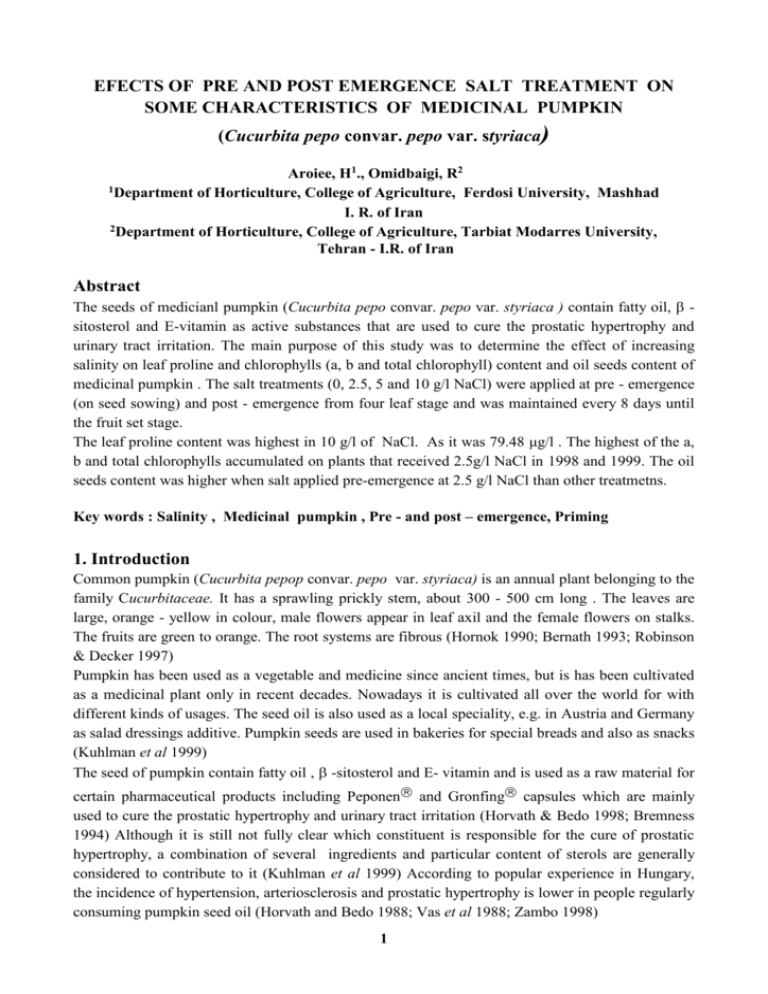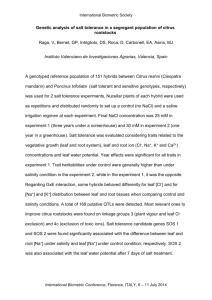3.3. Effect of salinity on oil seed content
advertisement

EFECTS OF PRE AND POST EMERGENCE SALT TREATMENT ON SOME CHARACTERISTICS OF MEDICINAL PUMPKIN (Cucurbita pepo convar. pepo var. styriaca) Aroiee, H1., Omidbaigi, R2 1Department of Horticulture, College of Agriculture, Ferdosi University, Mashhad I. R. of Iran 2Department of Horticulture, College of Agriculture, Tarbiat Modarres University, Tehran - I.R. of Iran Abstract The seeds of medicianl pumpkin (Cucurbita pepo convar. pepo var. styriaca ) contain fatty oil, sitosterol and E-vitamin as active substances that are used to cure the prostatic hypertrophy and urinary tract irritation. The main purpose of this study was to determine the effect of increasing salinity on leaf proline and chlorophylls (a, b and total chlorophyll) content and oil seeds content of medicinal pumpkin . The salt treatments (0, 2.5, 5 and 10 g/l NaCl) were applied at pre - emergence (on seed sowing) and post - emergence from four leaf stage and was maintained every 8 days until the fruit set stage. The leaf proline content was highest in 10 g/l of NaCl. As it was 79.48 μg/l . The highest of the a, b and total chlorophylls accumulated on plants that received 2.5g/l NaCl in 1998 and 1999. The oil seeds content was higher when salt applied pre-emergence at 2.5 g/l NaCl than other treatmetns. Key words : Salinity , Medicinal pumpkin , Pre - and post – emergence, Priming 1. Introduction Common pumpkin (Cucurbita pepop convar. pepo var. styriaca) is an annual plant belonging to the family Cucurbitaceae. It has a sprawling prickly stem, about 300 - 500 cm long . The leaves are large, orange - yellow in colour, male flowers appear in leaf axil and the female flowers on stalks. The fruits are green to orange. The root systems are fibrous (Hornok 1990; Bernath 1993; Robinson & Decker 1997) Pumpkin has been used as a vegetable and medicine since ancient times, but is has been cultivated as a medicinal plant only in recent decades. Nowadays it is cultivated all over the world for with different kinds of usages. The seed oil is also used as a local speciality, e.g. in Austria and Germany as salad dressings additive. Pumpkin seeds are used in bakeries for special breads and also as snacks (Kuhlman et al 1999) The seed of pumpkin contain fatty oil , -sitosterol and E- vitamin and is used as a raw material for certain pharmaceutical products including Peponen and Gronfing capsules which are mainly used to cure the prostatic hypertrophy and urinary tract irritation (Horvath & Bedo 1998; Bremness 1994) Although it is still not fully clear which constituent is responsible for the cure of prostatic hypertrophy, a combination of several ingredients and particular content of sterols are generally considered to contribute to it (Kuhlman et al 1999) According to popular experience in Hungary, the incidence of hypertension, arteriosclerosis and prostatic hypertrophy is lower in people regularly consuming pumpkin seed oil (Horvath and Bedo 1988; Vas et al 1988; Zambo 1998) 1 Salt stress is one of the major factors limiting plant productivity in semi - arid and arid regions around the world. Salinity causes a decline in primary metabolites resulting formation of intermediary products available for secondary metabolites synthesis (Soliman and Doss 1992; Morales et al 1993; Cano et al 1994; Kurban et al 1998). The grain and seed yield in wheat and fennel decreased, respectively with increasing salinity (Kinght et al 1992; Graifenberg et al 1996). Although, pharmaceutical effects of pumpkin seed oil have been widely investigated , no scientific study could be cited about salinity affecting plant growth and production of this crop neither in Iran nor in other countries. Thus, the main aim of the present study was to evaluate the leaf proline and chlrophylls and oil content of medicinal pumpkin under different saline conditions. 2. Material and methods 2.1. Salt priming of seeds Seeds of common pumpkin were soaked for 36 h at 20C in salt solutions containing 0, 2.5, 5 and 10 g/l NaCl. After priming treatments, the seeds were rinsed in distilled water and were set to germinate. 2.2. Salt treatment pre -and post - emergence The salt treatments were imposed by adding 0, 2.5 , 5 and 10 g/l NaCl to the half strength Hogland solution’s and were applied at two different times: pre - emergence (seed sowing) and post emergence (fourth leaf stage). In the both cases salt treatments were maintained at every 8 days until the fruit set stage. 2.3. Cultural conditions For germination and initial growth (up to 45 days from the beginning of the experiment) seeds were sown on sandy loam soil in a controlled greenhouse. The details of the physico chemical properties of the soil is shown in table-1. The plants were grown under field conditions with same soil after 45 days of planting. Salinity levels were established by adding NaCl to the aqueous solution made up with normal irrigation water. The EC - values of the salt treatments were 0, 3.90, 7.80 and 15.60 dsm-1, respectively . Seeds were sown in plots of 13.5 m 2.5 m size on May 5, 1998, in rows 250cm apart and a space of 50cm. The experiment was laid in a randomized compelet block design (RCBD) with three replications in every treatment. In each treatment there were 15 plants and five of them were sampled for analysis. Hoeing and mechanical weeding were done as and when required. Irrigation was given at regular intervals during the vegetative growth period. Other agronomic management practices were performed as and when needed. To study the effect of salinity on leaf proline, and chlorophylls content, samples were taken from developing leaves at flowering, stages. The fruit picking was done at full maturity when they become yellow - orange in colour under all the treatments during September. Seeds were manually separated, cleaned, washed and dried. Oil was extracted from 20 g of powdered seed with 300 ml n-hexane in a Soxhelt apparatus at 60°C. 2 Solutions were taken from the extract and were placed on a rotary evaporator. After removing the solvent the sample was dried in an oven at 80°C. The difference between the beaker containing oil and the empty beaker determined the amount of oil . Statistical data was analyzed for analysis of variance using the MSTATC software package and statistical differences were calculated according to Duncan’s multiple range test. 3. Results and discussion 3.1. Effect of salinity on proline The response of common pumpkin to salt treatments differed and the salt concentration and the time of treatment had different effect on the leaf proline content. The results show that application of 10g/l NaCl in both pre-and post emergence stages the leaf proline content was highest than the other trentments (Table 2). Levitte (1980), Salisbury and Ross (1991), Gunes et al., (1996) and Volkmrar et al., (1998) reported that when salinity treatments applied at the growth media, the increasing of leaf proline content accured. 3.2. Effect of salinity on chlorophylls The comparision of the means showed that the chlorophylls (a, b and total) at primary growth stages of the plant was heghest when salts applied at 5 and 10 g/l NaCl, but in flowering stages and in developing leaves the highest amount of a, b, and total leaf chlorophylls obtained at 2.5 g/l NaCl and with increasing salinity (from 2.5 to 10g/l NaCl) the chlorophylls level decreased (table 3). Gunes et al., (1996) reported that when salinity at the growing pepper media increased the leaf chlorophylls content decreased. Chen et al (1998) showed that in different vegetables increasing of salinity acompaied with decreasing leaf chlorphylls content. 3.3. Effect of salinity on oil seed content The results show that the seed priming had significant effect on the oil seed content (Fig.1). The highest oil content obtained when 2.5 g/l NaCl applied in pre-emergence salt treatment. 4. Discussion The effect of salt priming on common pumpkin are different. But using suitable salt concentration and suitable time of application have significant effect on the oil seed content of medicinal pumpkin . It seems applying of 2.5 g/l NaCl in pre - emergence treatment is more suitable for active substances of tested plant. 3 References 1. Bernáth J. 1993. Wild growing and cultivated medicinal plants (In Hungarian), Mezo . publ. Budapest, 566 pp. 2. Bremness L. 1994 Herbs. Dorling Kindresley, London , 304 pp. 3. Cano EA , Bolarin MC, Perez - Alfocea F, Caro M. 1994. Effect of NaCl priming on increased salt tolerance in tomato. Journal of Horticultural Science 66 : 621 - 628. 4. Chartzolakis KS. 1992. Effect of NaCl salinity on germination , growth and yield of greenhouse cucumber. Journal of Horticultural Science 67 : 115 - 119 . 5. Chen, K.; Hu, G.; Keutgen, N.; Janssens, M.J.J., and Lenz, F. (1999). Effects of NaCl salinity and CO2 enrichment on pepino (Solanum muricatum Ait). I. Growth and yield. Scientia Horticulturae, 81: 25-41. 6. Graifenberg AL, Giustiniani L, Lipucci Di paola M, 1996. Salinity affects growth, yield and elemental concentration of fennel. Horticultural Science 31 : 1131 - 1134. 7. Gunes, A.; Inal, A., and Alpuslun, M. (1996). Effect of salinity on stomata resistance, proline, and mineral composition of pepper. Journal of Plant Nutrition, 19: 389-396. 8. Hornok L. 1990 Cultivation and processing of medicinal plants (In Hungarian) , Mezo. publ. Budapest, 331 pp. 9. Horvath S. Bedo Z. 1988. Another possibility in treatment of hyperlipidaemia with peponen of natural active substance. Mediflora (special issue) 89 : 7- 8. 10. Knight SL, Rogers RB, Smith MAL, Spomer LA. 1992. Effect of NaCl Salinity on miniature dwarf tomato “Micro - tom” : I. Growth analyses and nutrient composition , Journal of plant nutrition 5 : 2315 - 2327. 11. Kuhlmann HK, Koetter U, Theurer C. 1999. Sterol contents in medicinal pumpkin (Cucurbita pepo convar. citrullinina var. styriaca). Acta Horticulturae 492 : 175 - 178. 12. Kurban H, Saceoka H, Nehria K. 1998 . Effect of salinity on growth and accumulation of organic and non organic solutes in the leguminous plants. Alhagi psedoalhagi and Vigna radiata. Soil Science and Plant Nutrition 44 : 586 - 597. 13. Levitte, J. (1980). Responses of Plants to Environmetal Stresses. 2nd edition. New York, Academic Press, USA 14. Morales CRM, Palazon J, Bonfill M. 1993. Response of Digitalis purpurea plant to temporary salinity . Journal of Plant Nutrition 16 : 327 - 335. 15. Robinson RW, Decker- Walters DS. 1997. Cucurbits . CAB International, Cambridge, 226 pp. 16. Salisbury, F. B., and Ross, C.W. (1991). Plant Physiology; 4th edition. Wadsworth publishing company. Belmont california pp. 682. 17. Soliman MS. Doss M. 1992. Salinity and mineral nutrition effects on growth and accumulation of organic and inorganic ions in two cultivated tomato varieties. Journal of Plant Nutrition 15 : 2789 - 2799. 18. Vas J, Walter G, Boromisza I. 1988 Experiences with peponen capsules in benign prostatic hypertrophy. Mediflora, (special issue ) 89 : 19- 20 . 19. Volkmar, K.M., Hu, Y., and Steppuha, H. (1997). Physiological responses of plant to salinity: A review. Canadian Journal of Plant Science, 78: 19-27. 20. Zambo I. 1998 . Importance of 7 - phytosterols in the treatment of prostatic hypertrophy. Mediflora (Special issue) 89 : 15 - 17. 4 Table -1. Physico - chemical characteristics of the experimental soil Electrical conductivity (dsm-1) PH Organic carbon (%) Total N (%) Available P (ppm) Available K (ppm) Texture 0.9 7.9 0.98 0.03 3.8 315 sandy loam Table-2. Effect of pre - and post emergence salt treatment on oil leaf proline content of medicinal pumkin (Cucurbita pepo convar. pepo var. styriaca) Treatment NaCl Proline (μg/l) (g/l) Pre - E Post - E 0 7.03 e 7.29 e 2.5 67.69 b 67.29 b 5 64.07 bc 63.7 bc 10 79.48 a 79.11 a Means followed by similar letters in each column are not significantly different at 5% level according to Duncan’s Multiple Range Test. Table-3. Effect of pre-and post emergence salt treatment on leaf chlorophylls (Cucurbita pepo convar. pepo var.styriaca) Treatment NaCl (g/l) 0 2.5 5 10 Measured characteristics (mg g fresh weight) Chlorophyll a Chlorophyll b Total Chlorophyll Pre – E Post - E per - E post - E Pre - E post - E 0.723 b 0.715 b 0.45 b 0.42 b 1.171 b 1.167 b 0.983 a 0.964 a 0.533 a 0.507 a 1.461 a 1.432 a 0.667 bc 0.646 bc 0.427 bc 0.413 bc 1.075 bc 1.058 bc 0.592 c 0.548 c 0.401 c 0.388 cd 0.947 c 0.983 c Means followed by similar letters in each column are not significantly different at 5% level according to Duncan’s Multiple range Test. 5 Fig. 1. Effect of pre - and post emergence salt treatment on seed oil of medicinal pumpkin (Cucurbita pepo convar. pepo var. styriaca) (P<5) 6







